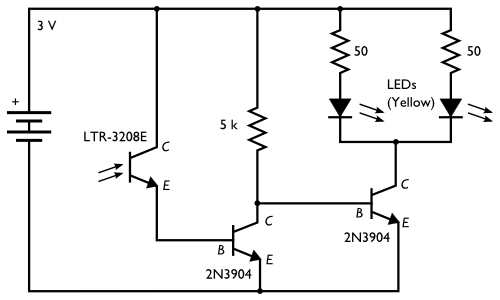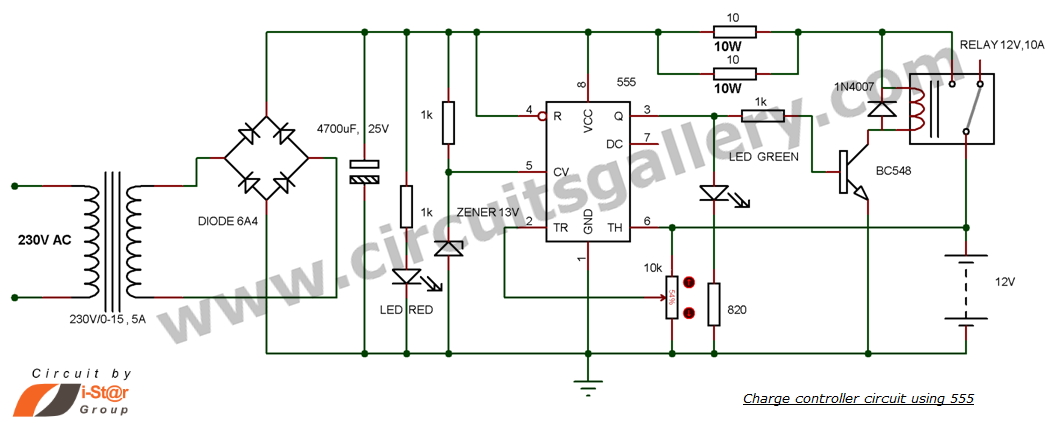
A dark detecting circuit for your jack lantern

Here is an inexpensive electronic circuit that can be built to place in a Jack-o'-lantern. It provides power to drive a few LEDs at night and automatically turns them off during the daytime. This is a simple and automatic dark-detecting circuit that can be used for a photosensitive pumpkin. While the minimalist circuit is compact and simple, it is limited in terms of sensitivity, LED driving capability, and extensibility. It can drive a single red or yellow LED from a lithium coin cell, but it requires fairly bright light (e.g., direct sunlight) to turn off the LED. A new dark-detecting circuit is more sensitive and can drive several bright LEDs for the Jack-o'-lantern. The basic circuit construction uses two LEDs for eyes and can be modified to use more or different types of LEDs. The photosensitive element is a phototransistor, specifically the LTR-3208E, which is infrared-sensitive with a dark lens. This phototransistor detects sunlight and incandescent lights but not fluorescent or most discharge lamps, ensuring it activates at night. The typical saturation current of this phototransistor is around 1 mA, meaning that under conditions less bright than sunlight, the output current is significantly lower. To increase sensitivity enough to detect indirect daylight, the phototransistor is used as part of a Darlington pair. When daylight is detected, the phototransistor turns on slightly, activating the first 2N3904 transistor, which pulls the base of the second 2N3904 to ground, preventing the LEDs from turning on. In darkness, no current flows through the phototransistor or the first 2N3904, allowing the base of the second 2N3904 to be pulled high through a 5 kΩ resistor, turning on the LEDs. The circuit draws 0.5 - 1 mA during the daytime and up to about 35 mA when driving the two LEDs at night. If superbright LEDs are used, larger load resistors may be necessary to reduce brightness and power consumption. The photosensitive part of the circuit is independent of the load driven by the second 2N3904, allowing for easy changes to the load. The circuit is designed with two LEDs, each with its own load resistor, but 1-4 parallel LEDs can be used if each has its own resistor. A solderless breadboard is recommended for initial testing. The flat side of the phototransistor indicates the collector pin (C), and the 2N3904 pins are arranged as Emitter, Base, Collector (E, B, and C from left to right). The LED's short lead or flatted face indicates the cathode. The circuit can also be constructed on a small piece of perfboard with twisted wire pairs connecting to the photosensor and LEDs. The circuit board is secured to a 2 x AA battery box.
The circuit operates on a simple principle of light detection and switching. The phototransistor, being sensitive to infrared light, allows the circuit to respond to ambient light conditions effectively. The Darlington pair configuration enhances the sensitivity of the circuit, making it capable of detecting lower light levels, such as those found in shaded areas or during twilight. The use of the 2N3904 transistors allows for efficient switching of the LED load, providing a means to illuminate the Jack-o'-lantern in the dark while conserving battery power during the day.
In terms of component selection, the LTR-3208E phototransistor is chosen for its responsiveness to infrared light, which is particularly useful in outdoor settings where various light sources can affect circuit performance. The 2N3904 transistors are standard NPN transistors that are widely available and suitable for low-power applications. The resistors used in the circuit play a crucial role in setting the biasing conditions for the transistors and limiting the current through the LEDs to prevent damage.
This circuit can be adapted for various applications beyond a Jack-o'-lantern, including decorative lighting for gardens or pathways, where automatic operation based on ambient light is desired. The straightforward design and use of commonly available components make it an excellent project for both beginners and experienced electronics enthusiasts.Here`s an inexpensive electronic circuit that you can build to put in your Jack-o`lantern. It provides power to drive a few LEDs at night, and automatically turns them off during the daytime. It`s a simple and automatic dark-detecting circuit that you can use to for your very own photosensitive pumpkin. While the minimalist circuit is marvelously compact and simple, it is limited both in terms of sensitivity, LED driving capability, and extensibility. It can drive a single red or yellow LED from a lithium coin cell but that`s it and it requires fairly bright light (e.
g. , direct sunlight) to turn off the LED. So our new dark-detecting circuit is only almost as compact or simple, but is much more sensitive, and is capable of driving several bright LEDs for your Jack-o`lantern. We`ll get started with the basic circuit construction, using two LEDs for eyes, and then look at how to modify the circuit to use more or different types of LEDs.
The photosensitive element is a phototransistor. We use type LTR-3208E here; it`s an infrared-sensitive type with a dark lens. Being IR sensitive it sees sunlight and incandescent lights, but not fluorescent or (most) discharge lamps- it really will come on at night. The typical "saturation" current of this type of phototransistor is only of order 1 mA, which means that under conditions much less bright than sunlight, we get much less than 1 mA of output current.
To increase the sensitivity of our pumpkin enough to detect indirect daylight lighting- not just direct sunlight- we use the phototransistor as one element of a Darlington pair. When daylight is detected, the phototransistor turns on (just a little bit), which turns on the first 2N3904, which pulls the base of the second 2N3904 to ground, and preventing the LEDs from turning on.
When it`s dark out, no current can flow through the phototransistor or the first 2N3904, which allows the base of the second 2N3904 to be pulled high through the 5 k transistor, which turns on the LEDs through that transistor. As drawn here, the circuit draws 0. 5 - 1 mA (depending on ambient light) when it`s daytime and up to about 35 mA when driving the two LEDs at night.
(If your LEDs are superbright types, you might want to cut down on brightness and power usage by using larger load resistors. ) The photosensitive part of the circuit is independent of what`s actually driven by the second 2N3904, so you can change the load applied there easily.
Our circuit is drawn with two LEDs, each with its own load resistor, however you can actually use 1-4 parallel LEDs if each has its own load resistor. ] A good place to start playing with a circuit like this is on a solderless breadboard. For the most part you can follow the circuit diagram. You`ll need to know that on our type of phototransistor the flat side that denotes the collector pin (C on the diagram).
Also, the pins of the 2N3904 are called (left-to-right) Emitter, Base, Collector (E, B, and C on the diagram), when viewing it from the front such that you can read the writing. On the LEDs, the side with the short lead and/or flatted faced on the lens is generally the cathode, which is the side with the flat bar in the diagram.
From there, we constructed the same circuit on a small piece of plain perfboard. There are three twisted wire pairs going off from this little board to (1) the photosensor and (2, 3) the LEDs. (There are really just the two transistors and three resistors on the board the resistor-looking thingies with one black stripe are just fancy wire jumpers.
) Here`s the whole setup with the phototransistor and LEDs visible at the ends of their wire leads. We use the long leads to be able to put the LEDs and sensor exactly where we want them in the pumpkin. We`ve protected the end of the leads with heat-shrink tubing. (No use shorting out our circuit with pumpkin goo. ) The circuit board is strapped to the 2 x AA battery box with a 🔗 External reference
The circuit operates on a simple principle of light detection and switching. The phototransistor, being sensitive to infrared light, allows the circuit to respond to ambient light conditions effectively. The Darlington pair configuration enhances the sensitivity of the circuit, making it capable of detecting lower light levels, such as those found in shaded areas or during twilight. The use of the 2N3904 transistors allows for efficient switching of the LED load, providing a means to illuminate the Jack-o'-lantern in the dark while conserving battery power during the day.
In terms of component selection, the LTR-3208E phototransistor is chosen for its responsiveness to infrared light, which is particularly useful in outdoor settings where various light sources can affect circuit performance. The 2N3904 transistors are standard NPN transistors that are widely available and suitable for low-power applications. The resistors used in the circuit play a crucial role in setting the biasing conditions for the transistors and limiting the current through the LEDs to prevent damage.
This circuit can be adapted for various applications beyond a Jack-o'-lantern, including decorative lighting for gardens or pathways, where automatic operation based on ambient light is desired. The straightforward design and use of commonly available components make it an excellent project for both beginners and experienced electronics enthusiasts.Here`s an inexpensive electronic circuit that you can build to put in your Jack-o`lantern. It provides power to drive a few LEDs at night, and automatically turns them off during the daytime. It`s a simple and automatic dark-detecting circuit that you can use to for your very own photosensitive pumpkin. While the minimalist circuit is marvelously compact and simple, it is limited both in terms of sensitivity, LED driving capability, and extensibility. It can drive a single red or yellow LED from a lithium coin cell but that`s it and it requires fairly bright light (e.
g. , direct sunlight) to turn off the LED. So our new dark-detecting circuit is only almost as compact or simple, but is much more sensitive, and is capable of driving several bright LEDs for your Jack-o`lantern. We`ll get started with the basic circuit construction, using two LEDs for eyes, and then look at how to modify the circuit to use more or different types of LEDs.
The photosensitive element is a phototransistor. We use type LTR-3208E here; it`s an infrared-sensitive type with a dark lens. Being IR sensitive it sees sunlight and incandescent lights, but not fluorescent or (most) discharge lamps- it really will come on at night. The typical "saturation" current of this type of phototransistor is only of order 1 mA, which means that under conditions much less bright than sunlight, we get much less than 1 mA of output current.
To increase the sensitivity of our pumpkin enough to detect indirect daylight lighting- not just direct sunlight- we use the phototransistor as one element of a Darlington pair. When daylight is detected, the phototransistor turns on (just a little bit), which turns on the first 2N3904, which pulls the base of the second 2N3904 to ground, and preventing the LEDs from turning on.
When it`s dark out, no current can flow through the phototransistor or the first 2N3904, which allows the base of the second 2N3904 to be pulled high through the 5 k transistor, which turns on the LEDs through that transistor. As drawn here, the circuit draws 0. 5 - 1 mA (depending on ambient light) when it`s daytime and up to about 35 mA when driving the two LEDs at night.
(If your LEDs are superbright types, you might want to cut down on brightness and power usage by using larger load resistors. ) The photosensitive part of the circuit is independent of what`s actually driven by the second 2N3904, so you can change the load applied there easily.
Our circuit is drawn with two LEDs, each with its own load resistor, however you can actually use 1-4 parallel LEDs if each has its own load resistor. ] A good place to start playing with a circuit like this is on a solderless breadboard. For the most part you can follow the circuit diagram. You`ll need to know that on our type of phototransistor the flat side that denotes the collector pin (C on the diagram).
Also, the pins of the 2N3904 are called (left-to-right) Emitter, Base, Collector (E, B, and C on the diagram), when viewing it from the front such that you can read the writing. On the LEDs, the side with the short lead and/or flatted faced on the lens is generally the cathode, which is the side with the flat bar in the diagram.
From there, we constructed the same circuit on a small piece of plain perfboard. There are three twisted wire pairs going off from this little board to (1) the photosensor and (2, 3) the LEDs. (There are really just the two transistors and three resistors on the board the resistor-looking thingies with one black stripe are just fancy wire jumpers.
) Here`s the whole setup with the phototransistor and LEDs visible at the ends of their wire leads. We use the long leads to be able to put the LEDs and sensor exactly where we want them in the pumpkin. We`ve protected the end of the leads with heat-shrink tubing. (No use shorting out our circuit with pumpkin goo. ) The circuit board is strapped to the 2 x AA battery box with a 🔗 External reference
Warning: include(partials/cookie-banner.php): Failed to open stream: Permission denied in /var/www/html/nextgr/view-circuit.php on line 713
Warning: include(): Failed opening 'partials/cookie-banner.php' for inclusion (include_path='.:/usr/share/php') in /var/www/html/nextgr/view-circuit.php on line 713





